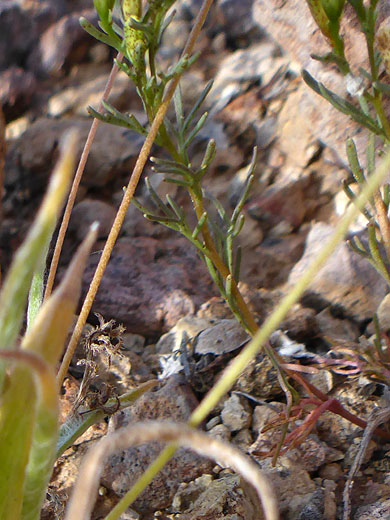
White and yellow flowerheads - thymophylla concinna at Pinkley Peak, Organ Pipe Cactus National Monument, Arizona
Common name:
Sonoran pricklyleaf
Family:
Scientific name:
Thymophylla concinna
Main flower color:
Range:
Far south Arizona
Height:
Up to 5 inches
Habitat:
Flats and washes in deserts; usually sandy locations, below 2,000 feet
Leaves:
Alternate, around half an inch long, divided into linear or thread-like lobes
Season:
February to May
Most species in this genus have bright yellow ray florets, but those of thymophylla concinna are usually pure white (less often pale yellow). This species has the most limited distribution in the US, found only in a small area of far south Arizona (Pima county); arid, desert terrain, hence plants tend to be small, just a few inches tall. Leaves are divided into 3 to 9 narrow, thread-like lobes, and are hairless. Stems grow vertically upwards or at an angle.
The base of the flowerhead may have one or two narrow, tapering bractlets, less than half the length of the phyllaries, which number between 8 and 16 and (like the leaves and stems) are dotted with prominent, dark oil glands. Phyllary edges are distinct for less than half their length. Flowerheads are formed of up to 25 bright yellow disc florets and between 9 and 12 broad ray florets. Rays have two lengthwise grooves, and when fully mature they bend back below the plane.
The base of the flowerhead may have one or two narrow, tapering bractlets, less than half the length of the phyllaries, which number between 8 and 16 and (like the leaves and stems) are dotted with prominent, dark oil glands. Phyllary edges are distinct for less than half their length. Flowerheads are formed of up to 25 bright yellow disc florets and between 9 and 12 broad ray florets. Rays have two lengthwise grooves, and when fully mature they bend back below the plane.
All Contents © Copyright The American Southwest | Comments and Questions | Contribute | Site Map

